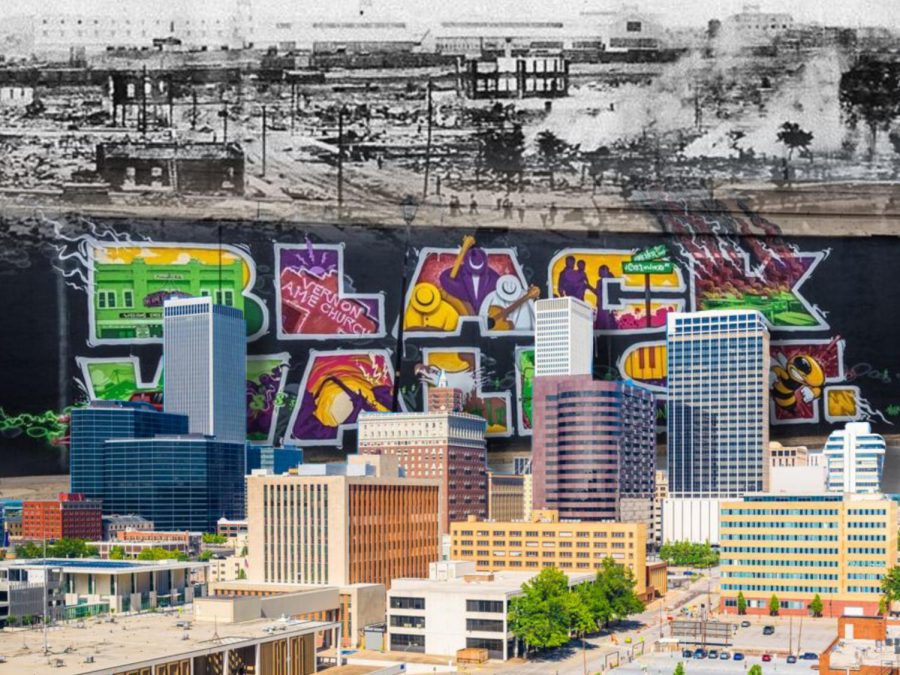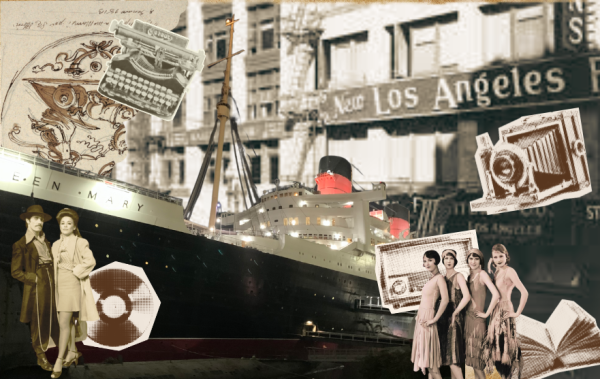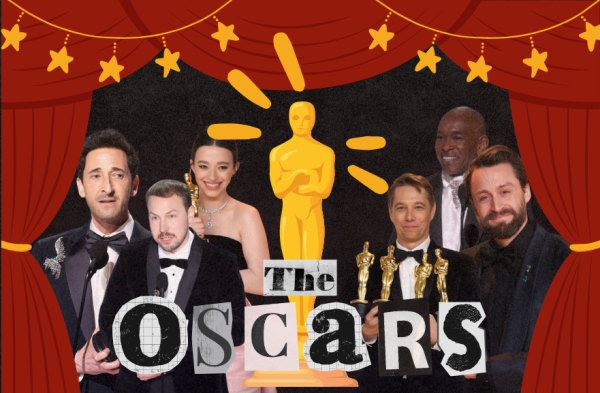A Look into the Tulsa Race Massacre of 1921
The Racist Past of the United States
Three images overlaid. In the background, in place of the sky, is a black and white image of Tulsa being destroyed. On the horizon line is an overlaid image of a mural from present-day Tulsa with the text “Black Wall Street,” a homage to the city’s history. In the foreground are the buildings from the current city of Tulsa. (Collage by: Gianna Nguyen)
*Trigger Warning: mentions of racial violence, sexual assault, and lynching*
With the now highly accessible dissemination of information people have at their fingertips these days, it has become increasingly apparent in recent years that the American public education system often teaches a diluted version of history to its students.
In world history courses, the United States is framed as a paternalistic foreign savior, gracefully intervening in the issues of pitiful “third world” countries who do not know how to govern themselves, and perpetuates a sense of American exceptionalism that distorts American perceptions of other countries. Even more disturbingly, U.S. history courses tend to gloss over the atrocities committed by the American government onto its own people in favor of glorifying the white and affluent historical figures we have all come to be familiar with.
This sanitization of history is dangerous because it promotes a nationalist mindset that can quickly turn violent, as was demonstrated by the siege of the U.S. Capitol on January 6, 2021. It also decontextualizes the outrage of marginalized groups as they loudly combat persisting systemic oppression, making bigotry seem like a personal responsibility to eradicate rather than institutions that need to be dismantled. This is why it is important to teach and to learn about American history that is often swept under the rug, since it highlights the oppressive systems that harm marginalized communities—especially for Black and Indigenous people of color (BIPOC)—and how these systems continue to impact them today.
One such historical event that demonstrates this particular blindspot would be the Tulsa Race Massacre, alternatively known as the Tulsa Race Riots.
What happened?
For context, within the city of Tulsa, Oklahoma, there is a neighborhood called Greenwood. Founded in 1906, Greenwood was home to many affluent Black Americans, a self-contained hub of successful businesses and a flourishing community lifestyle, and eventually came to be known as Black Wall Street. The district was established by O.W. Gurley, a wealthy Black landowner with “a vision to create something built for Black people, by Black people,” as reported by Hannibal Johnson, author of Black Wall Street: From Riot to Renaissance in Tulsa’s Historic Greenwood District.
As this was a time when racial segregation was still very much well and alive, Greenwood drew negative attention from the other side of the train tracks by its white neighbors. Black Americans living an upscale life was not only unthinkable to these racists, it was intolerable. Pre-existing racial tensions were heightened, ultimately culminating into the ensuing massacre.
The massacre was kickstarted by an event that took place on the morning of May 30, 1921, during which a young Black man named Dick Rowland was seen riding the elevator with a white woman named Sarah Page. Rumors quickly began to spread, each story account varying from person to person. To this day, no one knows exactly what happened in that elevator in the Drexel Building—the events have been muddied and lost to time to the point where it is uncertain whether Dick Rowland and Sarah Page were even those involved’s real names.
However, reports of Dick Rowland sexually assaulting Sarah Page were printed in the Tulsa Tribune, drawing outrage from the white community of Tulsa. The article was followed by another editorial stating there was a lynching planned for that night.
On May 31, 1921, Rowland was arrested and placed in a courthouse, which was then descended upon by an angry mob of about 1,500 white men. Around 25 armed Black men were standing guard to protect Rowland, who were soon to be joined by another 75 Black men due to the rumors of the planned lynching. However, they were still outnumbered. The ensuing confrontation between the two groups incensed the white rioters.
Because of this, over the course of the following two days, armed white mobs looted homes, burned down small businesses, and shot Black people in Greenwood. Some survivor accounts even report incendiary bombs being dropped from airplanes.
On June 1, 1921—the official end to the massacre—Oklahoma Governor Robertson declared martial law. National Guard troops arrived in Tulsa to help put out the fires and imprisoned the remaining Black Tulsans. For up to eight days, over 6,000 people were held at the Convention Hall and the Fairgrounds.
At the time, at least 800 people were treated for injuries. The death toll was reportedly 36 people (10 white and 26 Black), but historians now have reason to believe it was somewhere upward of 300 people killed.
All traces of this massacre were kept contained, much documentation of the incident disappearing mysteriously. It was not until 1997 that a Tulsa Race Riot Commission was formed by the state of Oklahoma to formally document and investigate the tragedy.
Why is this important?
This historical event gravely highlights the power dynamic between white women and men of color, particularly Black men. While white women are marginalized for their identity as women, they hold significant power over people of color (POC) because of their purported “fragility.” In other words, because white women are seen as weak and delicate due to gender roles created by the patriarchy, they can easily incite violence against POC by weaponizing the fact that society is built to protect them through a phenomenon colloquially known as white women’s tears. Events such as the Tulsa massacre highlight the importance of the concept of intersectionality—a critical race theory titled by civil rights activist, lawyer, and UCLA professor Kimberlé Crenshaw—and how crucial it is to introduce this theory to mainstream consciousness.
Beyond that, this tragedy utterly invalidates the idea that hard work will eventually lead to success in the United States. During the COVID-19 pandemic, people are rapidly becoming more conscious of how the U.S. thrives off of exploitative labor—particularly that of its so-called “essential workers,” who do the most arduous work while still earning less than a livable wage. The Tulsa Race Massacre gives this notion a historical basis by further supporting how absolutely empty the American Dream actually is. By all means, the residents of Tulsa had done everything right to “pull themselves up by the bootstraps” and arguably, they succeeded. Yet, after one explosive conflict, all of their hard work came crashing down in the most horrific way imaginable.
It is important to learn the dark, gory, and racist history of the United States to truly understand the way institutions systematically oppress minorities. It is necessary to contextualize the anger of BIPOC over the way they have been treated ever since the birth of this country. It is crucial to never dismiss criticisms of the U.S. and its government as unpatriotic or sensitive because there is a long history of pain that is rarely ever acknowledged outside of the affected groups.
Take a step back. Schools were only slowly desegregated starting from 1954, making current students only the second generation to go to fully integrated schools. There is still a long, difficult battle to fully unravel and extinguish the systemic oppression of minorities, and especially Black Americans, in the United States. Inherently racialized problems such as police brutality, food deserts, gentrification, redlining, medical racism, and so much more are still at large.
But with awareness, with activism, and with advocacy—it can only go uphill from here.
References:
“1921 Tulsa Race Massacre.” Tulsa Historical Society & Museum, www.tulsahistory.org/exhibit/1921-tulsa-race-massacre/
“Tulsa Race Massacre of 1921.” Encyclopædia Britannica, Encyclopædia Britannica, Inc., www.britannica.com/event/Tulsa-race-riot-of-1921.
Your donation will support the student journalists of Huntington Beach High School. Your contribution will allow us to cover our annual website hosting costs.
Thank you for supporting our program!







